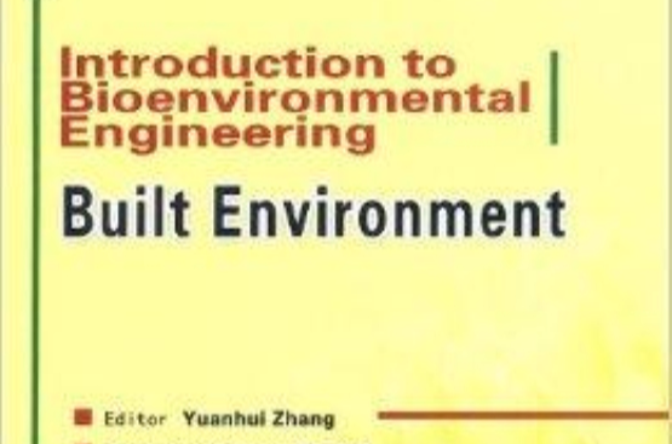《生物環境工程導論:建築環境》主要內容簡介:Human Thermal Comfort Zone、Thermal Control for Livestock Facilities、Heat Stress in Animal Production、Threshold Limits for Typical Indoor Pollutants等。
基本介紹
- 書名:生物環境工程導論:建築環境
- 作者:張源輝
- 出版日期:2010年12月1日
- 語種:英語
- ISBN:7565501409, 9787565501401
- 外文名:Introduction to Bioenvironmental Engineering-Built Environment
- 出版社:中國農業大學出版社
- 頁數:200頁
- 開本:16
- 品牌:中國農業大學出版社
內容簡介,圖書目錄,
內容簡介
《生物環境工程導論:建築環境》由中國農業大學出版社出版。
圖書目錄
Module 1 : Introduction
1.1 Air Composition
1.2 Variables and Units
1.3 Energy Use for Buildings
1.4 Course Objectives
1.5 Laboratory Report Policies
1.6 Recommended Laboratory Report Format
1.7 Lab Report Example
1.8 Homework Format
1.9 Homework Example
Module 2 : Psyehrometrics
2.1 Psychrometric Properties
2.2 Psychrometric Chart
2.3 Thermal Comfort Zone
2.4 Case Study: Psychrometrics Classroom Exercise
2.5 Problems
Module 3 : Psychrometric Processes
3.1 Sensible Heating or Cooling
3.2 Sensible Heating with Humidification
3.3 Sensible Cooling with Dehumidification
3.4 Evaporative Cooling
3.5 Adiabatic Mixing of Two Moist Air Streams
3.6 Problems
3.7 Laboratory Exercise: Psychrometrics
Module 4 : Calculation of Psychrometric Properties
4.1 Case Study: Calculation of Psychrometric Properties
Module 5 : Basics of Heat Transfer
5.1 Conduction Heat Transfer
5.2 Heat Conduction through a Multi-Layer Wall
5.3 Heat Conduction through a Parallel Wall
5.4 Convection Heat Transfer
5.5 Radiation Heat Transfer
5.6 Radiation Heat Exchange
5.7 Problems
Module 6 : Heat Transfer through a Building Envelope
6.1 Heat Transfer through a Wall
6.2 Heat Transfer through a Ceiling
6.3 Heat Transfer through a Floor
6.4 Heat Transfer through Exterior Perimeter
6.5 Case Study 1 : Improve energy efficiency for a building
6.6 Case Study 2 : Improve energy efficiency in a watch assembly plant Beijing, China
6.7 Laboratory Exercise: Heat transfer through building shelters
Module 7: Heat and Moisture Production within Buildings
7.1 Sensible Heat from Lights
7.2 Sensible Heat from Equipment
7.3 Heat and Moisture from Management Activities
7.4 Latent Heat and Moisture Relationship
7.5 Heat and Moisture Production of Occupants
7.6 Net Sensible Heat Transfer through Buildings
7.7 Net Moisture and Pollutants Production within Buildings
7.8 Carbon Dioxide Production
Module 8.Mass and Energy Balance for Ventilated Airspaces
8.1 Sensible Heat Balance Ventilation Requirement
8.2 Moisture Balance Ventilation Requirement
8.3 Pollutant Balance Ventilation Requirement
8.4 Minimum Ventilation Rates
8.5 Heating Capacity Calculation
8.6 Case Study: Ventilation Design for a Vehicle Cabin
8.7 Problems
8.8 Laboratory Exercise: Measuring Ventilation Rate in an Airspace
Module 9: Ventilation Graph
9.1 Heat Deficit Temperature
9.2 Maximum Ventilation Requirement
9.3 Work Sheet: Ventilation Requirement
9.4 Problems
9.5 Case Study: Ventilation Requirement
9.6 Laboratory Exercise: Fan Test Chamber
Module 10: Physiological Responses
10.1 Human Thermal Comfort Zone
10.2 Thermal Control for Livestock Facilities
10.3 Heat Stress in Animal Production
10.4 Threshold Limits for Typical Indoor Pollutants
Module 11 : Room Air Cleaning Efficiency
11.1 Case Study: Evaluation of Air Cleaning Devices
Module 12: Comprehensive Case Studies
12.1 Design a Cabin Minimum Air Flow Rate
12.2 Role Playing-Troubleshooting
12.3 Barn Description for Troubleshooting
Appendix 1 : Building Sector Energy Consumption
Appendix 2 : Psychrometric Property Calculations
Appendix 3 : Appendices from Louis D. Albright' s Book
References
Author' s Biography
Acknowledgement
1.1 Air Composition
1.2 Variables and Units
1.3 Energy Use for Buildings
1.4 Course Objectives
1.5 Laboratory Report Policies
1.6 Recommended Laboratory Report Format
1.7 Lab Report Example
1.8 Homework Format
1.9 Homework Example
Module 2 : Psyehrometrics
2.1 Psychrometric Properties
2.2 Psychrometric Chart
2.3 Thermal Comfort Zone
2.4 Case Study: Psychrometrics Classroom Exercise
2.5 Problems
Module 3 : Psychrometric Processes
3.1 Sensible Heating or Cooling
3.2 Sensible Heating with Humidification
3.3 Sensible Cooling with Dehumidification
3.4 Evaporative Cooling
3.5 Adiabatic Mixing of Two Moist Air Streams
3.6 Problems
3.7 Laboratory Exercise: Psychrometrics
Module 4 : Calculation of Psychrometric Properties
4.1 Case Study: Calculation of Psychrometric Properties
Module 5 : Basics of Heat Transfer
5.1 Conduction Heat Transfer
5.2 Heat Conduction through a Multi-Layer Wall
5.3 Heat Conduction through a Parallel Wall
5.4 Convection Heat Transfer
5.5 Radiation Heat Transfer
5.6 Radiation Heat Exchange
5.7 Problems
Module 6 : Heat Transfer through a Building Envelope
6.1 Heat Transfer through a Wall
6.2 Heat Transfer through a Ceiling
6.3 Heat Transfer through a Floor
6.4 Heat Transfer through Exterior Perimeter
6.5 Case Study 1 : Improve energy efficiency for a building
6.6 Case Study 2 : Improve energy efficiency in a watch assembly plant Beijing, China
6.7 Laboratory Exercise: Heat transfer through building shelters
Module 7: Heat and Moisture Production within Buildings
7.1 Sensible Heat from Lights
7.2 Sensible Heat from Equipment
7.3 Heat and Moisture from Management Activities
7.4 Latent Heat and Moisture Relationship
7.5 Heat and Moisture Production of Occupants
7.6 Net Sensible Heat Transfer through Buildings
7.7 Net Moisture and Pollutants Production within Buildings
7.8 Carbon Dioxide Production
Module 8.Mass and Energy Balance for Ventilated Airspaces
8.1 Sensible Heat Balance Ventilation Requirement
8.2 Moisture Balance Ventilation Requirement
8.3 Pollutant Balance Ventilation Requirement
8.4 Minimum Ventilation Rates
8.5 Heating Capacity Calculation
8.6 Case Study: Ventilation Design for a Vehicle Cabin
8.7 Problems
8.8 Laboratory Exercise: Measuring Ventilation Rate in an Airspace
Module 9: Ventilation Graph
9.1 Heat Deficit Temperature
9.2 Maximum Ventilation Requirement
9.3 Work Sheet: Ventilation Requirement
9.4 Problems
9.5 Case Study: Ventilation Requirement
9.6 Laboratory Exercise: Fan Test Chamber
Module 10: Physiological Responses
10.1 Human Thermal Comfort Zone
10.2 Thermal Control for Livestock Facilities
10.3 Heat Stress in Animal Production
10.4 Threshold Limits for Typical Indoor Pollutants
Module 11 : Room Air Cleaning Efficiency
11.1 Case Study: Evaluation of Air Cleaning Devices
Module 12: Comprehensive Case Studies
12.1 Design a Cabin Minimum Air Flow Rate
12.2 Role Playing-Troubleshooting
12.3 Barn Description for Troubleshooting
Appendix 1 : Building Sector Energy Consumption
Appendix 2 : Psychrometric Property Calculations
Appendix 3 : Appendices from Louis D. Albright' s Book
References
Author' s Biography
Acknowledgement

